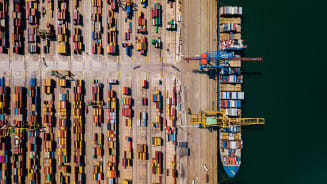35%
Four in five leaders we surveyed expect a recession, but only 35 percent feel very prepared for one.

As 2023 begins, many of the risks and challenges of 2022 remain. Organizations continue to address the effects of the COVID-19 pandemic, global economic uncertainty and workforce changes. Aon Global CEO Greg Case examines what steps business leaders should take to confront ongoing volatility and plan for business growth and resilience.
Over the past several years, the world has been experiencing increasing levels of volatility, and the growing awareness that risks once thought on the horizon — like climate change, the health-wealth gap, and cyber threats — are now here on our doorstep.
Recently, the world’s leading economists gathered in Jackson Hole, Wyoming, to discuss the extraordinary economic volatility of the last few years, including how this is likely to persist for many years to come. A member of the European Central Bank Board dubbed our current period the “Great Volatility” — contrasting it with what has been known as the “Great Moderation,” a period defined by consistent growth and relative stability.
Given this changing paradigm, the importance of making better decisions has never been greater.
What we have heard from our clients and have seen through our research is that the COVID-19 pandemic has forever changed the way leaders think about volatility and confront risk. So, while we all may be facing the challenges posed by this era of “Great Volatility,” there is also great opportunity.
We recently conducted our third annual survey of 800 C-suite and senior executives from around the world to identify the risks they are most concerned about and how prepared they are to turn that risk into opportunity.
Four in five leaders we surveyed expect a recession, but only 35 percent feel very prepared for one. We know that prepared leaders are essential to protecting an organization’s resilience and finding growth opportunities in the face of heightened volatility. What sets the leaders who are very prepared for an economic slowdown apart? And, just as importantly, what actions can leaders take to make better decisions that protect and grow their organizations in this environment?
Our research revealed that leaders who consider themselves prepared to weather these challenges share three fundamental characteristics.
Data shows that the most equipped leaders today view taking risks as an engine of growth. Sixty-two percent of the leaders we surveyed agree that their company’s appetite to address risk has increased in response to the current macroeconomic conditions.
This era of “Great Volatility” has changed how the best leaders approach risk and understand the true interconnectedness of risks today — in fact, 61 percent of leaders agree that risks are interconnected. Most executives don’t see the pandemic as a one-time event, but rather as a catalyst that exposed a myriad of new risks and strengthened their crisis response as leaders. In fact, the majority (73 percent) of the best-prepared leaders strongly believe that the pandemic prepared them to respond quickly to emerging interconnected risks, giving them added confidence as they head into a recession.
Talent recruitment and retention remains a top priority and challenge for C-suite and senior executives with the threat of a recession looming. How leaders make decisions around talent all comes down to the leaders’ appetite for risk. Our research showed that confident business leaders are resisting the impulse to slow hiring or delay long-term investments. Compared to other, less prepared leaders, almost double the percentage of very prepared leaders are spending a “great deal” of time on attracting and retaining top executive talent (42 percent vs. 22 percent, respectively). These leaders have a firm understanding that top talent is necessary to foster to build a resilient workforce for the future, regardless of market conditions.
Investing in the wellbeing of your workforce is just as critical as having the right people in place. It is why at Aon we created the position of Chief Wellbeing Officer in 2022, to not only drive our wellbeing and workforce resilience strategies for clients, but to also focus on wellbeing efforts for our own colleagues. Our research shows that 34 percent of prepared leaders say that stronger internal junior/mid-level resilience is helpful in responding to increased volatility, compared to 28 percent of other leaders.
Business leaders are facing a long list of near-term risks like inflation and a potential recession. The best leaders are taking immediate action to respond to the economic slowdown, but they are not letting that get in the way of investing for long-term growth and managing long-term risks.
The way leaders are managing climate change risk is a good example of where prepared leaders are investing for the long term. Leaders who are very prepared for economic volatility are looking ahead and spending more relative time on longer-term risks like climate change.
The reality is that climate risk is not a probability, it is a certainty — and severe weather is becoming more and more a part of everyday life. It is the ultimate example of the interconnectivity of risk. The strongest leaders are looking at the challenges caused by climate change beyond regulatory compliance and reputation management and are digging into the related risks where the impact is immediate and measurable — business interruption, material scarcity, supply chain issues and reputation damage. And we are seeing that the leaders who are investing more time and resources in addressing this challenge are better prepared as a result.
There is an important and necessary path forward leaders can take to prepare for the challenges ahead in an undoubtedly more complex and risky future. And they can do so in a way that creates greater opportunity for their organization, and in the case of climate change, benefits society as a whole.
General Disclaimer
The information contained herein and the statements expressed are of a general nature and are not intended to address the circumstances of any particular individual or entity. Although we endeavor to provide accurate and timely information and use sources we consider reliable, there can be no guarantee that such information is accurate as of the date it is received or that it will continue to be accurate in the future. No one should act on such information without appropriate professional advice after a thorough examination of the particular situation.
Terms of Use
The contents herein may not be reproduced, reused, reprinted or redistributed without the expressed written consent of Aon, unless otherwise authorized by Aon. To use information contained herein, please write to our team.
Four in five leaders we surveyed expect a recession, but only 35 percent feel very prepared for one.
Our Better Being podcast series, hosted by Aon Chief Wellbeing Officer Rachel Fellowes, explores wellbeing strategies and resilience. This season we cover human sustainability, kindness in the workplace, how to measure wellbeing, managing grief and more.
Stay in the loop on today's most pressing cyber security matters.
Our Cyber Resilience collection gives you access to Aon’s latest insights on the evolving landscape of cyber threats and risk mitigation measures. Reach out to our experts to discuss how to make the right decisions to strengthen your organization’s cyber resilience.
Our Employee Wellbeing collection gives you access to the latest insights from Aon's human capital team. You can also reach out to the team at any time for assistance with your employee wellbeing needs.
Explore Aon's latest environmental social and governance (ESG) insights.
Our Global Insurance Market Insights highlight insurance market trends across pricing, capacity, underwriting, limits, deductibles and coverages.
How do the top risks on business leaders’ minds differ by region and how can these risks be mitigated? Explore the regional results to learn more.
Our Human Capital Analytics collection gives you access to the latest insights from Aon's human capital team. Contact us to learn how Aon’s analytics capabilities helps organizations make better workforce decisions.
Explore our hand-picked insights for human resources professionals.
Our Workforce Collection provides access to the latest insights from Aon’s Human Capital team on topics ranging from health and benefits, retirement and talent practices. You can reach out to our team at any time to learn how we can help address emerging workforce challenges.
Our Mergers and Acquisitions (M&A) collection gives you access to the latest insights from Aon's thought leaders to help dealmakers make better decisions. Explore our latest insights and reach out to the team at any time for assistance with transaction challenges and opportunities.
How do businesses navigate their way through new forms of volatility and make decisions that protect and grow their organizations?
Our Parametric Insurance Collection provides ways your organization can benefit from this simple, straightforward and fast-paying risk transfer solution. Reach out to learn how we can help you make better decisions to manage your catastrophe exposures and near-term volatility.
Our Property Risk Management collection gives you access to the latest insights from Aon's thought leaders to help organizations make better decisions. Explore our latest insights to learn how your organization can benefit from property risk management.
Our Technology Collection provides access to the latest insights from Aon's thought leaders on navigating the evolving risks and opportunities of technology. Reach out to the team to learn how we can help you use technology to make better decisions for the future.
Trade, technology, weather and workforce stability are the central forces in today’s risk landscape.
Our Trade Collection gives you access to the latest insights from Aon's thought leaders on navigating the evolving risks and opportunities for international business. Reach out to our team to understand how to make better decisions around macro trends and why they matter to businesses.
With a changing climate, organizations in all sectors will need to protect their people and physical assets, reduce their carbon footprint, and invest in new solutions to thrive. Our Weather Collection provides you with critical insights to be prepared.
Our Workforce Resilience collection gives you access to the latest insights from Aon's Human Capital team. You can reach out to the team at any time for questions about how we can assess gaps and help build a more resilience workforce.

Article 7 mins
From global supply chain risks to climate insecurity, organizations face challenges and complexities on a scale rarely seen before.

Article 9 mins
Risk Capital CEO Andy Marcell and Human Capital CEO Lambros Lambrou discuss how innovations in Risk Capital and Human Capital can help organizations boost resilience and navigate volatility.

Report 28 mins
Global business leaders highlight risks linked to trade as some of their top concerns — both physical and financial. While the topic is complex and broad, there are opportunities that business leaders can pursue to stay ahead of emerging trade dynamics.